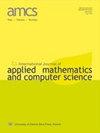有限状态机的层次结构在飞行模拟器飞行员交互训练中的应用
IF 1.2
4区 计算机科学
Q3 AUTOMATION & CONTROL SYSTEMS
International Journal of Applied Mathematics and Computer Science
Pub Date : 2021-12-01
DOI:10.34768/amcs-2021-0049
引用次数: 3
摘要
摘要提出了在飞行模拟器中进行飞行员交互训练的控制单元,即场景播放器的概念。这个场景玩家被建模为有限状态机的层次结构。这种方法可以将用于培训的增强现实显示设备的细节与负责内容上下文组织的系统核心模块分离开来。因此,本文的第一个贡献是将场景玩家的数学模型作为交互式学习系统自训练控制单元的通用公式,适用于各种情况,而不仅仅局限于飞行模拟器相关程序。第二个贡献是通过对模型的广泛模拟实现的实验验证,这证明了所提出的方法能够通过跟踪最终用户的偏好来适当地自组织上下文信息的细节。对于后一种目的,原始算法是从统计分析中衍生出来的,包括贝叶斯推理。通过对波音737飞机机长飞行前程序的实际应用,说明了该方法的有效性。本文章由计算机程序翻译,如有差异,请以英文原文为准。
A hierarchy of finite state machines as a scenario player in interactive training of pilots in flight simulators
Abstract The paper presents the concept of a control unit, i.e., a scenario player, for interactive training pilots in flight simulators. This scenario player is modelled as a hierarchy of finite state machines. Such an approach makes it possible to separate the details of an augmented reality display device which is used in training, from the core module of the system, responsible for contextual organization of the content. Therefore, the first contribution of this paper is the mathematical model of the scenario player as a universal formulation of the self-trained control unit for interactive learning systems, which is applicable in a variety of situations not limited solely to flight simulator related procedures. The second contribution is an experimental verification achieved by extensive simulations of the model, which proves that the proposed approach is capable to properly self-organize details of the context information by tracing preferences of the end users. For that latter purpose, the original algorithm is derived from statistical analysis, including Bayesian inference. The whole approach is illustrated by a real application of training the preflight procedure for the captain of the Boeing 737 aircraft in a flight simulator.
求助全文
通过发布文献求助,成功后即可免费获取论文全文。
去求助
来源期刊
CiteScore
4.10
自引率
21.10%
发文量
0
审稿时长
4.2 months
期刊介绍:
The International Journal of Applied Mathematics and Computer Science is a quarterly published in Poland since 1991 by the University of Zielona Góra in partnership with De Gruyter Poland (Sciendo) and Lubuskie Scientific Society, under the auspices of the Committee on Automatic Control and Robotics of the Polish Academy of Sciences.
The journal strives to meet the demand for the presentation of interdisciplinary research in various fields related to control theory, applied mathematics, scientific computing and computer science. In particular, it publishes high quality original research results in the following areas:
-modern control theory and practice-
artificial intelligence methods and their applications-
applied mathematics and mathematical optimisation techniques-
mathematical methods in engineering, computer science, and biology.

 求助内容:
求助内容: 应助结果提醒方式:
应助结果提醒方式:


